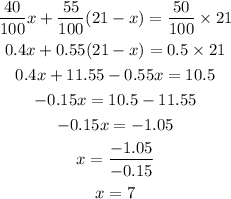Given that the chemist has one solution that is 40% alcohol and another that is 55% alcohol.
We can find how much of each in liters must she used to make 21 L of a solution that is 50% alcohol below.
Since we don't have the quantity of each solution of the alcohol we would be mixing, we would assume the following.

Therefore, we would have

Since x =7, we would then get the quantity of each alcohol as

Therefore, the answer is
